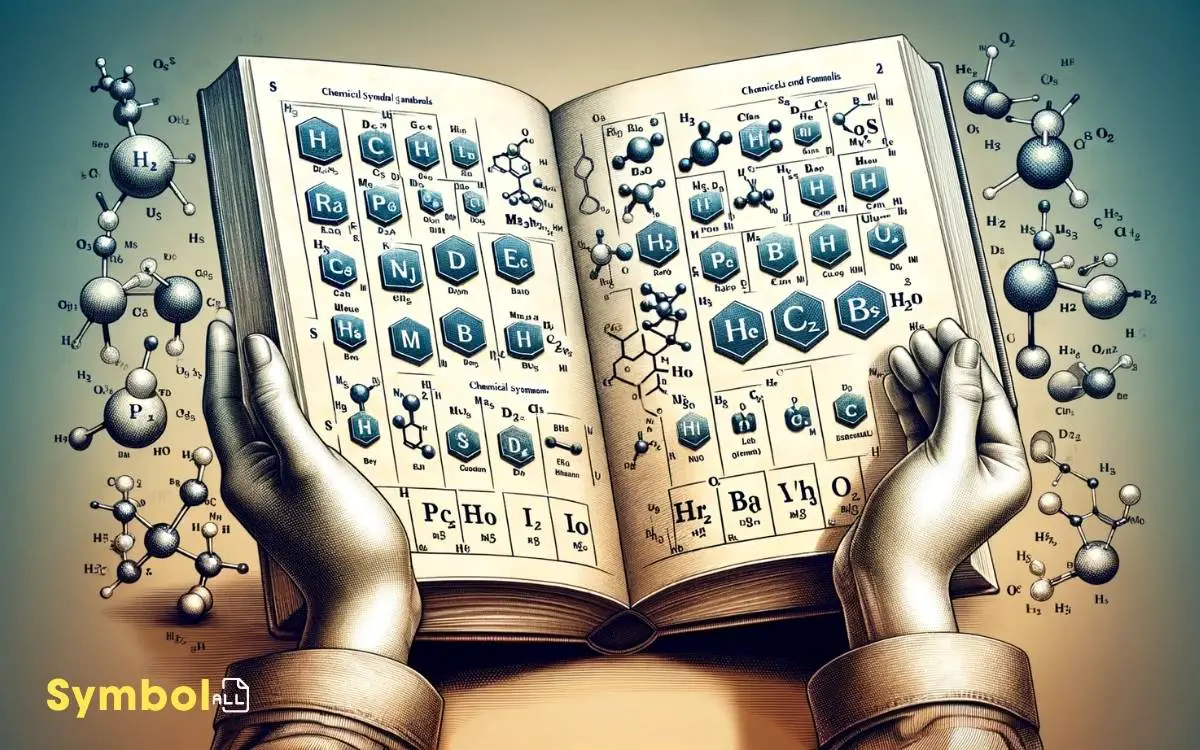What Are Chemical Symbols and Chemical Formulas Used for?
Chemical symbols and formulas are your essential tools for understanding the intricate world of chemistry. These symbols, derived from element names, offer a concise and precise representation of elements.
Meanwhile, formulas reveal the structure of compounds, showcasing the ratios and combinations of these elements.
Together, they act as a universal language, streamlining communication across scientific fields and minimizing errors in chemical identification and manipulation.
By mastering symbols and formulas, you’re equipped to predict reactions and quantify substances accurately.
The knowledge of these critical tools enhances your capacity to collaborate internationally and grasp molecular dynamics, promising deeper insights into chemical behaviors and interactions.

Key Takeaways
Defining Chemical Symbols
Chemical symbols universally represent elements in a concise and precise manner, enabling scientists to communicate complex information efficiently. These symbols, typically consisting of one or two letters derived from their Latin names, eliminate language barriers and allow for consistent global understanding. The chemical symbols used today are standardized by the International Union of Pure and Applied Chemistry (IUPAC), ensuring uniformity across scientific disciplines. This standardized system not only facilitates collaboration but also simplifies the study and application of chemistry in both academic and industrial settings.
Each symbol consists of one or two letters, derived from the element’s name, often in Latin. For instance, ‘H’ denotes hydrogen, while ‘Fe’ stands for ferrum, Latin for iron.
This standardization facilitates unambiguous communication across the global scientific community, ensuring that regardless of language barriers, the elemental composition of compounds is understood.
It’s crucial you grasp the significance of these symbols; they’re not arbitrary but are systematically assigned based on historical and linguistic criteria.
Understanding them is foundational in chemistry, as they serve as the basic language for expressing the composition of substances, reactions, and molecular structures, without delving into the more complex chemical formulas.
Understanding Chemical Formulas
You’ll first learn how to decode the structures of compounds by examining their chemical formulas.
This involves understanding the proportional relationships between elements, which is crucial for grasping the composition of any compound.
Lastly, mastering essential nomenclature skills will enable you to accurately communicate and interpret these chemical formulas.
Decoding Compound Structures
To grasp a compound’s structure, it’s essential to decode its chemical formula, a concise representation of the elements and their proportions within the molecule.
This decoding process involves translating symbols and numerical subscripts into a visual representation of the compound’s atomic arrangement.
For instance, H2O denotes two hydrogen atoms bonded to a single oxygen atom, forming water. Each element symbol reflects a specific type of atom, while the subscript indicates the quantity of those atoms present.
Elements Proportional Relationships
Building on your ability to decode compound structures, understanding chemical formulas further illuminates the proportional relationships between elements in a compound, offering insights into its chemical behavior and properties.
Each formula signifies the exact ratio of elements, crucial for predicting reactions and outcomes. For instance, H2O reveals a 2:1 ratio of hydrogen to oxygen, dictating its unique characteristics and reactivity.
This ratio is foundational, determining the compound’s physical state, reactivity, and compatibility with other substances.
Grasping these proportional relationships allows you to anticipate how compounds interact, form, or decompose under various conditions.
It’s a fundamental aspect of chemistry that enables the precise manipulation of substances, fostering innovations and advancements in fields ranging from medicine to environmental science.
Essential Nomenclature Skills
Mastering the art of interpreting chemical formulas is crucial for delving into the complexities of chemical reactions and understanding the intricate balance of elements within compounds.
Chemical formulas, like H2O for water or CO2 for carbon dioxide, aren’t just random assortments of letters and numbers. They’re a concise fusion of symbols and subscripts that convey the exact composition of molecules.
Each symbol represents a specific element, while the subscript denotes the number of atoms of that element present in the molecule. For instance, in CO2, the ‘C’ signifies carbon, and the ‘O’ with a subscript of ‘2’ indicates two oxygen atoms.
Grasping this nomenclature lets you predict the behavior of substances under various conditions, fostering a deeper comprehension of chemical processes.
Simplifying Complex Information
Understanding chemical symbols and formulas requires distilling complex concepts into more accessible, digestible information.
This simplification process is vital for several reasons:
- Universal Language: Chemical symbols and formulas act as a universal language across scientific disciplines, making complex chemical compositions understandable worldwide.
- Efficiency in Communication: They allow for the concise representation of substances and their reactions, saving space and time in scientific discourse.
- Error Reduction: Simplifying information reduces the potential for misunderstandings and errors in chemical identification and manipulation.
- Educational Tool: They serve as foundational elements in education, enabling students to grasp intricate chemical relationships through simplified representations.
Facilitating Global Collaboration
Chemical symbols and formulas are pivotal in fostering global scientific collaboration. They provide a standardized method for sharing complex data across borders.
This universal language enables scientists, regardless of their geographical location or native tongue, to precisely communicate findings, hypotheses, and methodologies without ambiguity. It’s the bedrock for publishing research, exchanging ideas, and developing international projects.
When you delve into the minutiae, these symbols and formulas encapsulate vast amounts of information molecular structures, compositions, and potential interactions all in a compact, universally understandable format.
This efficiency is crucial in accelerating research and innovation, allowing for seamless integration of knowledge from diverse fields.
Thus, the adoption of this standardized system is instrumental in advancing scientific discovery on a global scale, transcending linguistic and cultural barriers.
Predicting Chemical Reactions
To accurately predict chemical reactions, you must first grasp the intricacies of reaction outcomes. This hinges on the reactants’ properties and conditions.
You’ll need to master balancing equations, a fundamental skill that ensures the law of conservation of mass is upheld.
Identifying reaction types is crucial as well. It allows you to categorize reactions, simplifying prediction and analysis.
Understanding Reaction Outcomes
Predicting the outcomes of chemical reactions requires a deep knowledge of reactant properties and reaction conditions.
To accurately foresee reaction products, you’ll need to understand the nuances of how substances interact under various circumstances.
This predictive capability hinges on several critical factors:
- Reactivity of Elements: Recognizing how reactive certain elements are can determine potential reaction pathways.
- Stoichiometry: Quantitative relationships in chemical reactions guide the proportions of reactants and products.
- Energy Changes: Knowing whether a reaction absorbs or releases energy helps in predicting its feasibility.
- Solubility Rules: These determine whether a solid precipitate forms in aqueous solutions.
Mastering these concepts allows you to predict reaction outcomes with precision, enabling a deeper comprehension of chemical processes and facilitating your ability to manipulate them for desired results.
Balancing Equation Essentials
Understanding the outcomes of chemical reactions sets the stage for mastering the art of balancing equations, a key skill in accurately predicting reaction products.
In essence, balancing equations is about ensuring that the number of atoms for each element is equal on both sides of the equation. This principle, known as the law of conservation of mass, dictates that matter can’t be created or destroyed in a chemical reaction.
You’ll start by identifying the reactants and products, then proceed to balance the equation by adjusting coefficients, not the chemical formulas.
This process requires a methodical approach, often starting with elements that appear in only one reactant and one product.
Mastery of balancing equations allows you to predict the amounts of substances consumed and produced, enabling precise experimental planning and interpretation of results.
Identifying Reaction Types
Identifying reaction types serves as a critical skill in accurately forecasting the outcomes of chemical interactions. Recognizing the nature of a reaction allows you to predict the products and understand the process at a molecular level.
Here are key reaction types you’ll encounter:
- Synthesis reactions, where simpler substances combine to form a more complex product.
- Decomposition reactions, which involve a single compound breaking down into simpler substances.
- Single displacement reactions, where an element displaces another in a compound.
- Double displacement reactions, characterized by the exchange of ions between two compounds.
Understanding these categories not only aids in predicting chemical reactions but also in conceptualizing how substances interact at an atomic level, fostering a deeper comprehension of chemical processes.
Decoding Substance Properties
Decoding the properties of substances requires a meticulous examination of their chemical symbols and formulas. You’ll find that these symbols and formulas aren’t just arbitrary; they’re a concise representation of the substance’s composition and, implicitly, its properties.
For instance, knowing the chemical formula allows you to deduce the molecular weight, which is crucial for calculating concentrations in solutions.
Furthermore, the arrangement of elements within the formula can hint at the substance’s reactivity, stability, and even its physical state under certain conditions.
Enhancing Educational Tools
Given the importance of chemical symbols and formulas in revealing the properties of substances, it’s imperative to explore how educational tools can be enhanced to better convey this complex information.
To achieve this, consider integrating:
- Interactive simulation software: Provides real-time experimentation and visualization of chemical reactions.
- Augmented reality (AR) applications: Offers immersive experiences, making abstract chemical concepts tangible.
- Adaptive learning platforms: Tailors content and pace according to individual learning needs, reinforcing understanding.
- Comprehensive databases: Enables quick access to extensive information on chemical properties and safety data sheets.
These advancements in educational technology can significantly improve the way you grasp and interact with the intricate world of chemistry, making learning both effective and engaging.
Conclusion
In navigating the vast ocean of chemistry, chemical symbols and formulas serve as your compass and map. They simplify intricate molecular structures into digestible information, enabling you to predict reactions and decode substance properties with precision.
This linguistic toolkit not only streamlines global scientific collaboration but also enriches educational resources, transforming complex concepts into accessible knowledge.
By mastering these symbols and formulas, you’re equipped to explore the molecular world with confidence, making every discovery a step towards uncharted territories.






